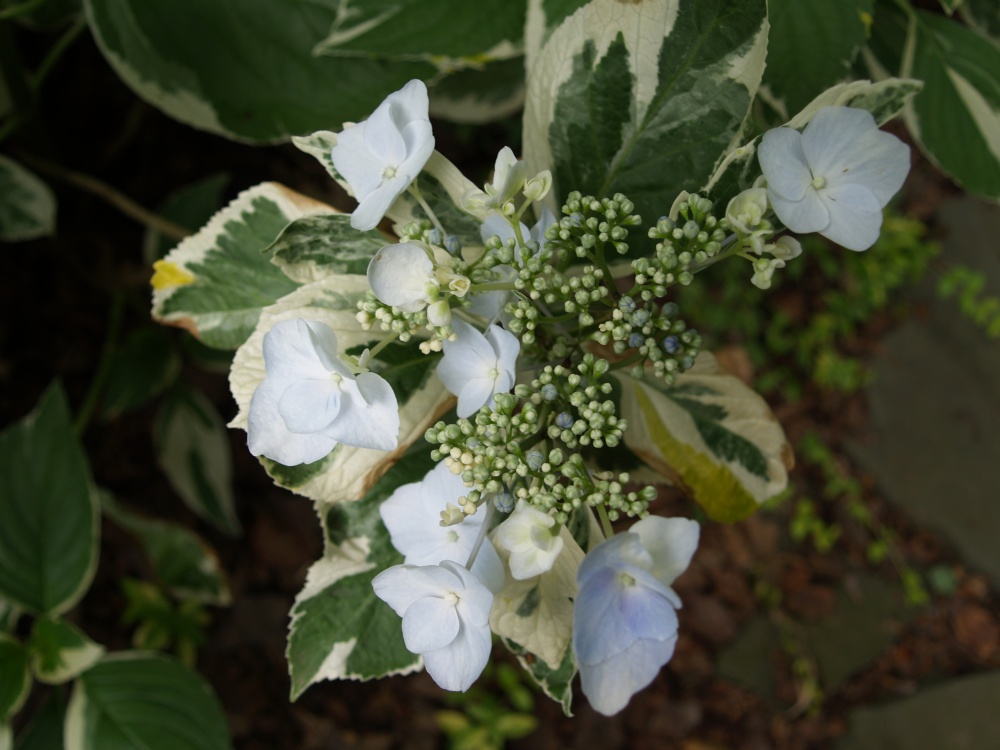In twenty years in this Virginia garden I don’t believe that I have seen the hydrangeas bloom so beautifully. Many years hydrangeas suffer damage to the blooming branch tips through the winter, and then will bloom sporadically or not at all, except for remontant types that flower on the current year’s growth. With heavy snow in the past winter many hydrangeas were buried and not subjected to freezing temperatures and harsh, drying winds, so damage was minimal.
In the past the mophead hydrangeas (Hydrangea macrophylla) such as Nikko Blue were the most likely to suffer winter injury, but newer cultivars flower on new spring growth and rebloom through the summer. In the acidic clay soils in Virginia the blooms of mopheads Endless Summer, Penny Mac, and Mini Penny are blue, but pink in neutral or alkaline soil. Since the flowering buds that developed last fall were not damaged the bushes are larger and fuller, and the first flush of blooms in early June has been extraordinary.
The remontant (reblooming) hydrangeas flower through the summer in my garden, pausing a bit in the heat and drought of August, but resuming with vigor in September until frost kills the foliage in October. I have planted a few each of several cultivars in a range from shade to nearly full sun and the blooming varies little, though in sunnier spots they routinely wilt in the midday sun, then perk up at sundown.
There are two variegated leaf hydrangeas (Hydrangea macrophylla ‘Maresii variegata’, above) in the garden, but with different character, which is not surprising since variegated leaves are often variable and prone to reversion back to green with many plants. In nearly full sun (with a break in late afternoon) one hydrangea grows above a stone wall overlooking the small pond in the front of the house with a compact form, with green leaves and narrow white borders. The other, in more shade than sun, is more open in habit with varying patterns and splotches of white, and an occasional splash of yellow. To the best of my recall (shaky at best) this will be the first year that I have seen flowers on either, but they are splendid if only for their foliage.
The large, coarsely textured, oak-like leaves of Oakleaf hydrangea (Hydrangea quercifolia, above), and delightful, long lasting, burgundy fall color, make this hydrangea especially appealing. Oakleaf will tolerate sun, but prefers more shade, and the large white blooms stand out like a beacon from shade at the forest’s edge. The growth habit is more irregular and taller than most hydrangeas, but for a border planting there are few shrubs that are superior.
The mophead hydrangeas have large, half round balls of blooms, and Oakleaf has long panicles, but lacecap hydrangeas (Hydrangea macrophylla normalis) have flat, broad flowers with petals only on the outside edges. The effect is lovely, but not as extravagant as the massive blooms of other hydrangeas. In addition to the variegated hydrangea, there are two lacecaps in the garden, ‘Lady in Red’ (above) and ‘Twist-n-Shout’ (below).
Neither bloomed well in their first year in the garden, but they have not disappointed since. Twist-n-Shout is a rebloomer, and though Lady in Red flowers only once, the blooms show color for a month or longer before fading nearly to red. The rich, dark leaves and stems make this an exceptional summer blooming shrub.
I,too,haven’t seen our hydrangias ever bloom so well-thanks for the explanation-it sure makes going thru the winter blizzards all worthwhile!
PS Live in Northern VA too.
Interesting! My hydrangeas are doing well too — although the Endless Summer hydrangeas I have never disappoint me.